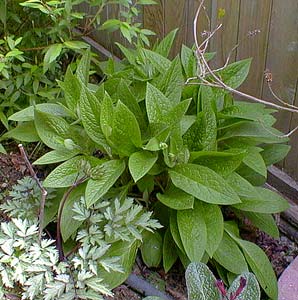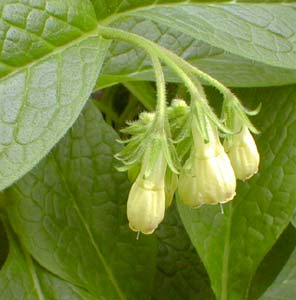
Borage; aka,
Tuberous Comfrey
"A little space of green expanse, the cove
Is closed by meeting banks, whose yellow flowers
Forever gaze on their own drooping eyes,
Reflected in the crystal calm."
-Percy Bysshe Shelley
(1792-1822)
(1792-1822)
Tuberous Comfrey (Symphytum tuberosum) is a large-leaf borage which spreads via rhizomes from its initial clump. It thrives in sun or part shade, & can be rather too aggressive if it finds conditions ideal.
A common garden escapee, it has naturalized in woodlands of Ireland, Maine, & the North American west coast, but is rarely a common plant in any setting. Though it can be a good foot tall, it is in general smaller & tidier than the majority of comfreys.
It grows wild in European woodlands in damp, dappled shade, & along riverbanks. In the garden it requires persistent moisture & falls flat on a hot dry day, though it won't be as sickly as it momentarily appears & a good ground-soaking perks it right up. So long as it does not experience drought, it will adapt to a wide range of soil conditions from loamy to sandy to clayey, with pH ranging from a bit acidic to a bit alkaline.
 Hardy to minus twenty degrees F., it dies to the ground in winter, but the root is still worming its way about. It will return in spring larger than it had been in autumn.
Hardy to minus twenty degrees F., it dies to the ground in winter, but the root is still worming its way about. It will return in spring larger than it had been in autumn.The root can be divided virtually year-round, as nothing shocks it save dryness. The roots are very close to the surface & one needs only slice off a shallow bit with a spade to translpant elsewhere or give to friends.
In May & June, tubular pale yellow flowers rise above the foliage on stems eight inches to a foot, & dangle in small clusters.
By tradition, the leaves & thick roots have long been used medicinally for numerous ailments, a few of which it may actually assist, given that that the plant has several alkaloids that are potentionally either harmful (to the liver) or curative. These alkaloids include allantoin, symlandine, & anadoline, among others.
Leaves pressed against minor cuts & scrapes may well accelerate healing. In the middle ages a bath with comfrey leaves in the water was believed to restore virginity, & an astringent capacity well might tighten the vagina for a harlot to fake maidenliness for sake of a pricier fee!
The youngest leaves can be used as an herb in cooked recipes, but can be mildly toxic & of unpleasant hairy texture if tried raw. The root makes a tasty & non-acidic alternative to coffee. To prepare for this purpose, clean & pound the root, roast until it is brown & brittle, then grind it into a powder for a drip-filter.